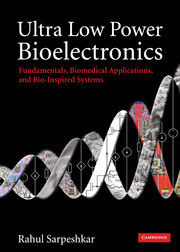Book contents
- Frontmatter
- Contents
- Acknowledgements
- Section I Foundations
- 1 The big picture
- 2 Feedback systems: fundamentals, benefits, and root-locus analysis
- 3 MOS device physics: general treatment
- 4 MOS device physics: practical treatment
- 5 MOS device physics: small-signal operation
- 6 Deep submicron effects in MOS transistors
- 7 Noise in devices
- 8 Noise in electrical and non-electrical circuits
- 9 Feedback systems
- 10 Return-ratio analysis
- Section II Low-power analog and biomedical circuits
- Section III Low-power RF and energy-harvesting circuits for biomedical systems
- Section IV Biomedical electronic systems
- Section V Principles for ultra-low-power analog and digital design
- Section VI Bio-inspired systems
- Section VII Energy sources
- Bibliography
- Index
- Epilogue
- References
3 - MOS device physics: general treatment
from Section I - Foundations
Published online by Cambridge University Press: 02 December 2010
- Frontmatter
- Contents
- Acknowledgements
- Section I Foundations
- 1 The big picture
- 2 Feedback systems: fundamentals, benefits, and root-locus analysis
- 3 MOS device physics: general treatment
- 4 MOS device physics: practical treatment
- 5 MOS device physics: small-signal operation
- 6 Deep submicron effects in MOS transistors
- 7 Noise in devices
- 8 Noise in electrical and non-electrical circuits
- 9 Feedback systems
- 10 Return-ratio analysis
- Section II Low-power analog and biomedical circuits
- Section III Low-power RF and energy-harvesting circuits for biomedical systems
- Section IV Biomedical electronic systems
- Section V Principles for ultra-low-power analog and digital design
- Section VI Bio-inspired systems
- Section VII Energy sources
- Bibliography
- Index
- Epilogue
- References
Summary
Intuition will tell the thinking mind where to look next.
Jonas SalkTo deeply understand any electronic circuit, whether it is low power or not, it is essential to have a good mastery of the devices from which that circuit is made. In this chapter, we will begin our study of device physics with the metal oxide semiconductor (MOS) transistor, the most important active device in electronics today. The MOS transistor is a field effect transistor (FET) and MOSFETs are abbreviated as nFETs if their current is due to electron flow and as pFETs if their current is due to hole flow. In this chapter, we shall focus on fundamental principles and on exact mathematical descriptions that are applicable to transistors built in technologies with relatively long dimensions. In later chapters, we shall study practical approximations needed to simplify these exact mathematical descriptions (Chapter 4), study small-signal dynamic models of the MOS transistor (Chapter 5), and discuss effects observed in deep submicron transistors with relatively short dimensions (Chapter 6).
Figure 3.1 shows a zoomed-in view of an n-channel FET or nFET built in a standard bulk complementary metal oxide semiconductor (CMOS) process. There are four terminals referred to as the gate (G), source (S), drain (D), and bulk (B), respectively. The control terminal, the metal-like polysilicon gate, is insulated from the silicon bulk via a silicon dioxide insulator; the source and drain terminals are created with n+ regions in the p-type silicon bulk.
- Type
- Chapter
- Information
- Ultra Low Power BioelectronicsFundamentals, Biomedical Applications, and Bio-Inspired Systems, pp. 57 - 83Publisher: Cambridge University PressPrint publication year: 2010



